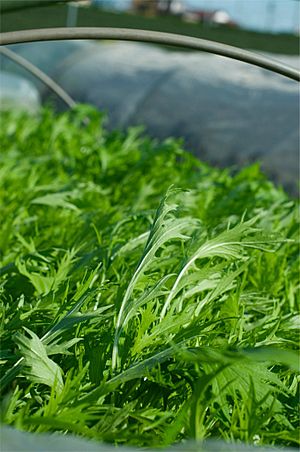Mizuna facts for kids
Quick facts for kids Mizuna |
|
|---|---|

Mizuna
|
|
| Species | Brassica rapa var. niposinica |
| Cultivar | Mizuna |
Mizuna, also known as kyona or Japanese mustard greens, is a type of plant. It's a special kind of Brassica rapa var. niposinica, which is a plant family that includes things like cabbage and broccoli. People often call it "water greens" because of its name in Japanese.
Contents
What is Mizuna?
Mizuna has dark green leaves with jagged edges. When you eat it raw, it has a slightly peppery taste. It's a bit spicy, but not as strong as arugula.
People use mizuna in many dishes. It's great in stir-fries, soups, and Japanese hot pots called nabemono.
How Mizuna Grows
Mizuna is a plant that grows quickly. It has many stalks with dark green leaves that are deeply cut and look fringed. These leaves have a fresh, crisp taste. You can eat them on their own or cook them with meat. In Japan, people often enjoy mizuna pickled. It can handle cold weather well and is grown a lot during winter in Japan.
Mizuna is not only good to eat, but it also looks nice! It has shiny, dark green leaves with jagged edges and thin white stalks. It can even look good in flower beds. This plant is strong, can adapt to different places, and is easy to grow in most soils. Mizuna greens have a mild mustard plant flavor.
You can usually plant mizuna outside from early to late summer. You can also plant it in late spring or early summer. If you plant it too early, it might "bolt," which means it goes to seed too quickly. Another option is to plant it in early autumn and then move it indoors or under cover.
Cooking and Storing Mizuna
This vegetable usually grows to be about 14 to 16 inches tall. Its leaves are green and yellow, smooth, and a bit feathery. You can find mizuna as a full-grown green or as a smaller, more tender "baby" version.
You can steam, boil, or stir-fry mizuna. It's also great mixed with other greens in a salad, especially with Red Asian Mustard greens. When you cook mizuna, it shrinks to about half its size. So, you need a lot of it to make a cooked dish with only mizuna.
You can find mizuna in many grocery stores, especially from early spring to late summer. When you pick mizuna, look for fresh, crisp leaves and avoid any that look discolored. You can keep mizuna fresh for four to five days if you wrap it in plastic and store it in the vegetable drawer of your refrigerator.
Different Types of Mizuna
There are many different kinds of mizuna! Even though "mizuna" is one name, it can refer to at least two different species of Brassica plants. Plant experts have also given names to many varieties of mizuna.
For example, a list from Cornell University and the United States Department of Agriculture names sixteen different types. Some of these include "Early Mizuna," "Kyona Mizuna," "Komatsuna Mizuna," "Vitamin Green Mizuna," "Kyoto Mizuna," "Happy Rich Mizuna," "Summer Fest Mizuna," "Tokyo Early Mizuna," "Mibuna Mizuna," "Red Komatsuna Mizuna," "Waido Mizuna," and "Purple Mizuna." There is also a type called pink mizuna.
Growing Mizuna
Mizuna has been grown in Japan for a very long time, since ancient times. A cool fact is that mizuna was even successfully grown on the International Space Station in 2019!
Mizuna can grow in many different climates, from hardiness zones 4 to 9. It likes a lot of sun or a little bit of shade. It also prefers soil that drains water well and has a pH level between 6.5 and 7.0. You can grow mizuna as tiny "microgreens" by planting seeds every 3 centimeters. Or, you can grow it for its full leaves by spacing the plants about 20 centimeters apart.
See also
 In Spanish: Mizuna para niños
In Spanish: Mizuna para niños



